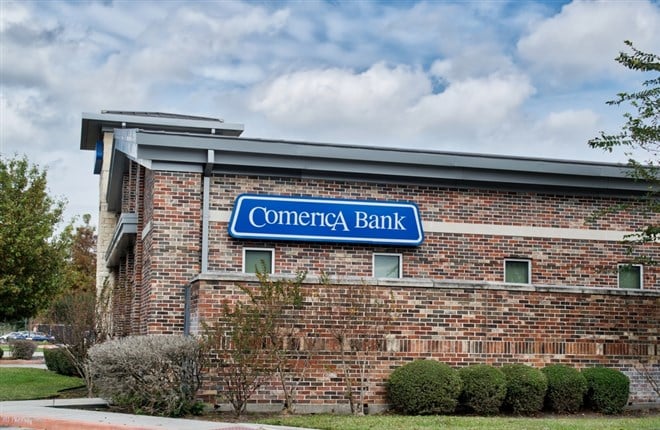
If stocks were Olympic athletes, Comerica Incorporated (NYSE: CMA) would represent Team USA in the sport of banking. Approximately every four years, the Dallas-based regional bank seems to make a nice run and then regroups for the next heat.
Its arch nemesis isn’t J.P. Morgan or Charles Schwab, but it is named Benjamin Franklin. Not the mutual fund company — the hundred dollar bill.
Twice the stock made a run to the $100 level only to be stymied by selling pressure. In 2018, the prospect of falling interest rates was the culprit. This year’s slide from $102 to $65 coincides with a rising rate environment. What gives?
Even with the potential for higher net interest income, regional bank stocks have been hampered by macro concerns. A slowdown in economic activity generally means a slowdown in lending activity. Higher mortgage rates have hurt as well. So we have a tug-of-war going on.
With the S&P Regional Banking index stabilizing recently, the group could be gearing up for a rebound rally. After posting record Q3 results, Comerica appears to be at an inflection point. It is fundamentally undervalued and technically oversold, a good combination for outperformance—and a possible third attempt at clearing the $100 hurdle.
What Does Comerica Do?
Comerica has been around since the horse and buggy era. Its roots trace back to 1849 when it served a thriving Lake Erie community of shipyards and sawmills as Detroit Savings Fund Institute. Over 170 years later, it operates 430 branches across Michigan, Arizona, Florida, California and its new home state of Texas.
The company’s resilience alone makes it an attractive long-term investment. Neither the Great Depression nor the Great Recession could put the company out of business, not to mention a couple of World Wars. Its recent struggles to overcome $100 aside, this is a company that is built for the long haul and one that has split multiple times.
Today, Comerica is split into three segments — Retail Banking, Commercial Banking and Wealth Management. Together they offer a full range of traditional savings accounts, checking accounts, loans and investments to U.S. consumers and businesses. True to its history, the commercial side of the business accounts for the majority of profits — 82% in the most recent period.
How is Comerica Performing This Year?
Since Comerica relies heavily on business lending activity, it has experienced a revival in the post-pandemic economy. Last year earnings per share surged 155%, creating a new base from which to grow.
With three quarters in the books this year, Comerica is reaping the benefits of higher interest rates and an expanding loan book that is defying worries of reduced lending activity.
Last week, the company notched its best-ever third-quarter performance highlighted by 37% EPS growth. This had much to do with the all-important net interest margin (NIM) expanding from 2.23% in the prior year quarter to 3.50%. But it coincided with a $3 billion increase in the loan balance that showed American businesses are still taking on growth projects despite mounting recessionary fears.
Comerica’s revenue rose sequentially for the second straight quarter in Q3 and the $2.60 in EPS was an all-time high. Full-year earnings are expected to be up only slightly from last year’s $8.35 but the Street sees EPS growing well beyond 2021 levels next year thanks to higher rates and a high credit quality loan book that limits bad debt.
What are Comerica’s Growth Prospects?
With the Fed poised to march ahead with its rate hiking mission, Comerica should continue to derive growth from a higher NIM and healthy loan growth. The consensus forecast for 2023 EPS implies 19% growth over this year and a 6.5x forward P/E ratio. This is a small price to pay for a regional bank with increasing rates and loan activity in its favor.
Comerica shares have been unfairly dragged lower with industry peers primarily because of less appealing mortgage rates and recession fears. Investors need to be less concerned about these factors since Comerica: 1) is a commercial-led bank with limited retail mortgage exposure, 2) has a strong presence in Texas where oil-related businesses are booming and in need of capital to fund growth initiatives and 3) has shown an ability to grow its loan book in the face of an economic slowdown.
Aside from having a below-peer P/E ratio, Comerica screams value on account of its shareholder-friendly track record. Despite the Covid setback, the bank has increased its dividend in each of the last 11 years — and has ample room for further dividend growth given the low 27% payout ratio. The forward yield of 4.2% is comfortably ahead of the 3.2% financial sector average.
Chart watchers will also note that Comerica has slipped outside the lower Bollinger Band. It has historically bounced off this lower range, and Friday’s high volume recovery suggests bargain hunters are starting to sniff out the stock.
Look for Comerica to trend higher after a record quarter in a weakened economy. It could eventually rise to the podium as a big 2023 winner.






